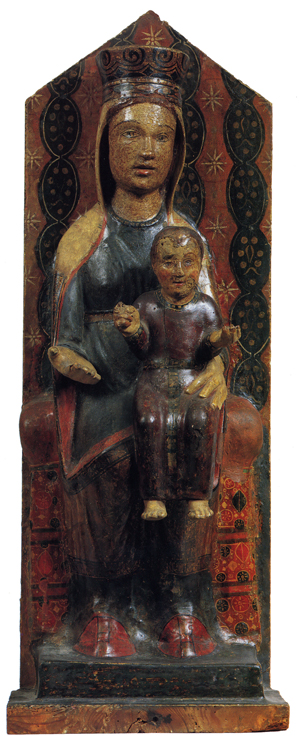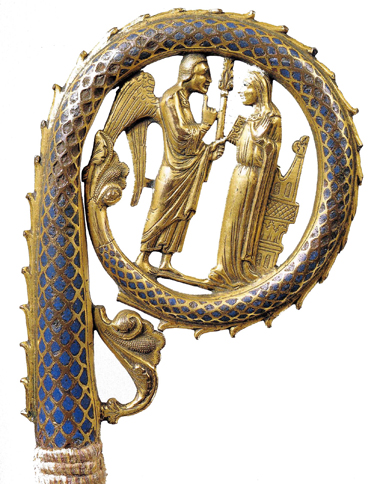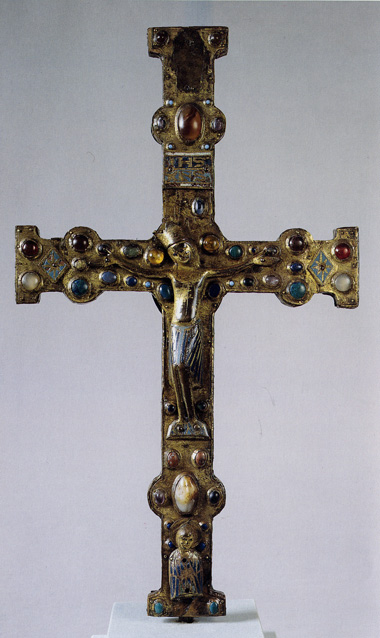|
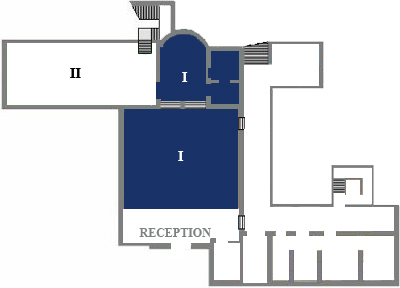
The physical appearance of Room 1 betrays its early function as a church, despite the 19th-century alterations. As if to suggest a dialogue between the container and its content, religious objects have been displayed here: ivory and enamel pieces, jewels, gems, gold work, glasswork, small sculptures and singular art objects.
|
|
Roman Art
Portrait of Agrippina Maggiore
first half of 1st century A.D.
The small amethyst head is datable to the first half of the 1st century A.D. Broken off at the base of the neck and showing some surface splintering, it leans slightly left and forward. The hairstyle, with the hair gathered back in a low bun made up of several intertwined plaits, the youthful appearance, the decidedly rounded oval of the face, the low forehead and full mouth, all lead to its identification as Agrippina Maggiore, the wife of Germanicus and mother of Caligula.
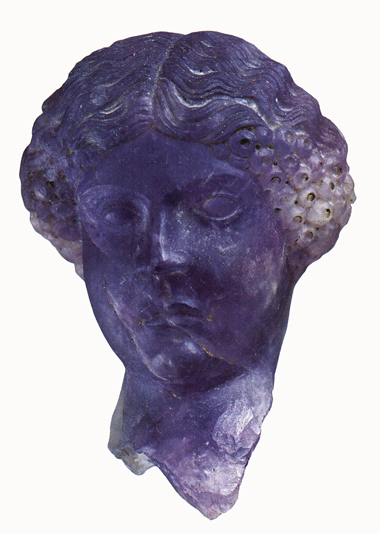
|
|
Umbrian sculpture
Madonna in Majesty with Blessing Child
mid- 13th century
This work by an Umbrian sculptor from about halfway through the 13th century is extraordinarily well conserved and still shows its original polychromy, apart from some small overpaintings.
It conforms to the iconography of mediaeval wooden sculpture and shows the Enthroned Madonna, in this case crowned as Queen of the Heavens, in frontal position with Baby Jesus in the act of blessing in her lap, sitting on his Mother's knees.
The iconography of the Holy Child in the act of blessing with His right hand (the fingers have broken off) and with His left hand holding the globe of the world (now lost), is that of the Salvator Mundi, while that of the Virgin with her right hand outstretched and open palm turned upwards, in the act of donating her own Son, underlines her role as intermediary between Christ and the faithful.
|
|
Limoges
Scroll of pastoral crosier with the Annunciation
mid- 13th century
This is the curled end, or riccio, of an abbot's or bishop's crosier, produced in Limoges about halfway through the 13th century and made of copper enamelled with the champlevé technique. This technique consisted of working the metal object, leaving empty honeycomb-shaped cells which were then filled with enamel paste; after firing, this paste glazed over and became smooth and level with the metal surface. At the centre of the scroll, decorated with a trellis pattern and reinforced by a serrated gold-plated copper crest, is the group of the Annunciation in relief, made with a mould. The Virgin, surprised by the arrival of the Angel, rises from the throne with her left hand raised. The Archangel bears the lily-shaped sceptre and has his index finger under his chin as if to attract the Virgin's attention.
|
|
France, Paris
Openwork plaque with crucifixion
second quarter of 14th century
This ivory plaque with lancet arch and no background support shows the crucifixion with the two mourners in abundant drapery and the symbols of the sun and moon. It was produced in Paris in the second quarter of the 14th century. The floral decoration on the cusp and the side pinnacles, separately worked and applied, might derive from a restoration intervention. The lack of a background support might also be due to a later manipulation. From the iconographical point of view, this precious small tablet is kind of the small ivory travelling or domestic altarpieces which were particularly widespread in France in the 13th and 14th centuries.
|
|
Limoges
Processional cross
mid to late 13th century
The processional cross, produced in Limoges in the third quarter of the 13th century, consists of copper foil affixed to a wooden background, then gilded, engraved and decorated with enamelling and cabochon stones.
This object, the expression of collective spirituality, was the liturgical symbol which led the procession of the faithful. In view of its function, the processional cross was decorated on both sides.
On the back of the cross the copper figure of Christ was separately cast and attached. Of particular note are the long pleated loin-cloth worked in champlevé (see Scroll of pastoral crosier above), the small side plaques and those decorating the reverse side of this precious processional cross.
|
|
Bartolomeo de Magonibus
Monstrance
1437
The presence of the crucifix with the two mourners at the top of this sacral casket dated 1437 indicates that it was originally designed as a monstrance. The miniature Gothic temple with its pointed arches decorated with pinnacles and finials stands on a polylobate base. The stem develops into a knup of six aedicules decorated with figurines of saints. From the long dedicatory inscription on the base we can deduce the date of production and name of the craftsman, the goldsmith Bartolomeo de Magonibus who worked in Milan in the years around 1437.

|
